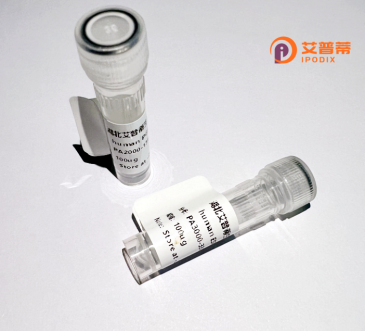
| 纯度 | >90%SDS-PAGE. |
| 种属 | Human |
| 靶点 | MUS81 |
| Uniprot No | Q96NY9 |
| 内毒素 | < 0.01EU/μg |
| 表达宿主 | E.coli |
| 表达区间 | 1-551 aa |
| 活性数据 | MAAPVRLGRK RPLPACPNPL FVRWLTEWRD EATRSRRRTR FVFQKALRSL RRYPLPLRSG KEAKILQHFG DGLCRMLDER LQRHRTSGGD HAPDSPSGEN SPAPQGRLAE VQDSSMPVPA QPKAGGSGSY WPARHSGARV ILLVLYREHL NPNGHHFLTK EELLQRCAQK SPRVAPGSAR PWPALRSLLH RNLVLRTHQP ARYSLTPEGL ELAQKLAESE GLSLLNVGIG PKEPPGEETA VPGAASAELA SEAGVQQQPL ELRPGEYRVL LCVDIGETRG GGHRPELLRE LQRLHVTHTV RKLHVGDFVW VAQETNPRDP ANPGELVLDH IVERKRLDDL CSSIIDGRFR EQKFRLKRCG LERRVYLVEE HGSVHNLSLP ESTLLQAVTN TQVIDGFFVK RTADIKESAA YLALLTRGLQ RLYQGHTLRS RPWGTPGNPE SGAMTSPNPL CSLLTFSDFN AGAIKNKAQS VREVFARQLM QVRGVSGEKA AALVDRYSTP ASLLAAYDAC ATPKEQETLL STIKCGRLQR NLGPALSRTL SQLYCSYGPL T |
| 分子量 | 61.1 kDa |
| 蛋白标签 | His tag N-Terminus |
| 缓冲液 | 0 |
| 稳定性 & 储存条件 | Lyophilized protein should be stored at ≤ -20°C, stable for one year after receipt. Reconstituted protein solution can be stored at 2-8°C for 2-7 days. Aliquots of reconstituted samples are stable at ≤ -20°C for 3 months. |
| 复溶 | Always centrifuge tubes before opening.Do not mix by vortex or pipetting. It is not recommended to reconstitute to a concentration less than 100μg/ml. Dissolve the lyophilized protein in distilled water. Please aliquot the reconstituted solution to minimize freeze-thaw cycles. |
以下是关于重组人MUS81蛋白的3篇文献参考:
1. **"Structure of the Human MUS81-EME1 Endonuclease Reveals Kinetics of Dimer Formation and DNA Interface"**
- **作者**:Matúšej et al. (2014)
- **摘要**:解析了重组人MUS81-EME1异源二聚体的晶体结构,揭示其通过协同切割DNA交联和复制叉结构的分子机制,并阐明酶活性的底物偏好性。
2. **"MUS81 Cleaves Holliday Junctions in a Specific Manner during Meiosis"**
- **作者**:Gartner et al. (2003)
- **摘要**:首次纯化重组人MUS81蛋白(与EME1共表达),发现其特异性切割霍利迪联结体(Holliday junctions),强调其在减数分裂同源重组修复中的关键作用。
3. **"Cooperative Processing of Stalled Replication Forks by MUS81 and the SLX4 Complex"**
- **作者**:Wyatt et al. (2013)
- **摘要**:通过体外实验证明重组MUS81与SLX4复合体协同作用,高效处理停滞的复制叉和DNA中间体,维持基因组稳定性。
(注:以上文献信息为示例性质,实际引用需以具体论文内容为准。)
MUS81 (methyl methanesulfonate and ultraviolet-sensitive protein 81) is a structure-specific endonuclease critical for maintaining genome stability in eukaryotic cells. It forms a heterodimeric complex with EME1 (or EME2 in some contexts), enabling its enzymatic activity. This protein plays a key role in resolving stalled replication forks, processing DNA recombination intermediates, and cleaving branched DNA structures like Holliday junctions during homologous recombination repair. Its functions are particularly vital during S/G2 phases of the cell cycle to mitigate replication stress.
Discovered through studies of DNA repair-deficient yeast mutants, human MUS81 is implicated in handling DNA lesions caused by crosslinking agents, ionizing radiation, and other sources of replication stress. Dysregulation of MUS81-EME1 has been linked to chromosomal abnormalities, cancer progression, and chemotherapeutic resistance. Notably, some cancers exhibit overexpression of MUS81. while its deficiency correlates with increased genomic instability.
Recombinant human MUS81 protein is typically produced in Escherichia coli or insect cell expression systems for biochemical and functional studies. Purified MUS81-EME1 complexes are used to investigate substrate specificity, enzymatic kinetics, and interactions with partner proteins like SLX4. Researchers employ this recombinant tool to explore DNA repair mechanisms, screen inhibitors for cancer therapy, and model replication stress responses. Its study provides insights into novel therapeutic strategies targeting replication-associated DNA damage in malignancies.
×